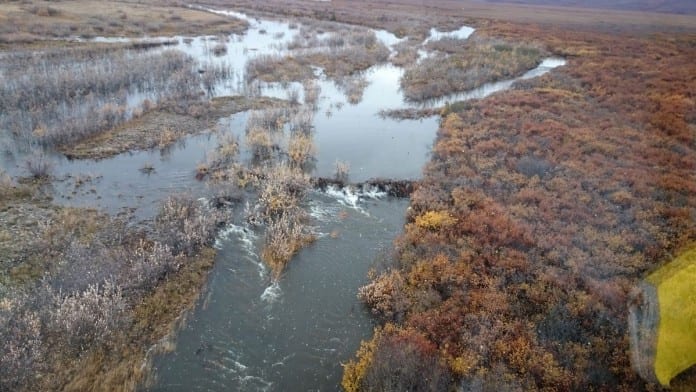
While skepticism about global warming continues in some circles, one group has cast their vote in affirmation.
“As woody shrubs move north in a warming Arctic, so do beavers,” wrote Yereth Rosen in the April 21 edition of Alaska Dispatch News. “Wood-chomping beavers have apparently established a beachhead near the Arctic coastline.”
A Canadian team documented the first beaver dam, lodge and winter food cache on the Beaufort Sea coastal plain in Yukon’s Ivvarik National Park. In case you have forgotten your Alaska history, a reminder that the Yukon was the location of another famous invasion, by pioneers totting gold pans, rather than big incisors.
The article mentions that beavers are considered a “keystone species, creating habitat for some species, and destroying habitat for other.” Humans are among those affected.
“In some sites in Northwest Alaska, where beaver are increasing, there are complaints that the multitude of dams are impeding fish movement and making boat travel more difficult, according to surveys by the National Park Service.”
Ironically, the same thing happened on the Copper River Delta following the nine-foot uplift caused by the 1964 Good Friday Earthquake. Alder and willow marched outward across flats formerly flooded by big tides, and soon beaver followed, building hundreds of dams across smaller gutters and sloughs.

Photo courtesy of the International Cryptozoology Museum
Prior to the earthquake, legendary Cordova boatman Harry Curran once ran the Copper King, a 60-foot tender, through the Lower Cutoff. The deep, narrow waterway was inland from the edge of the Delta, connecting Alaganik with Pete Dahl slough. It is now impassable, due to a series of beaver dams.
The article mentions that the Brooks Range creates “a formidable obstacle to beaver colonization on the Arctic Alaska coastal plain.”
So perhaps beaver dams won’t be a problem in Barrow. However, researchers are befuddled by how the large rodents are migrating to some of the new locations, with no obvious waterways for them to follow. One potential pathway is the ocean.
“Beavers aren’t supposed to swim in the seas, without a doubt, but wildlife often surprises us”, said Thomas Jung, a senior wildlife biologist with the Yukon territorial government.
Oh boy. Now Copper River fishermen may have issues not only with sea lions and seals, but also eager beavers towing large alders.
Hopefully, another adaptation to warmer climes by modern day furry Castoroides will not be a growth in size. Prior to the last ice age, beavers were the largest rodents in North America. They were about the size of modern black bears, reaching 8 feet in length, 3.5 feet in height, weighing 450 to 500 pounds, and sporting 6-inch chompers.
Lest you dismiss the possibility of warmer conditions yielding larger beavers, consider the sighting of a 200-pound beaver in the Oxbow Regional Park in Multnomah County, Oregon. Nicknamed “Deepak Chompra” by park naturalists, it first was observed on a grainy camera-trap photo swimming 20 feet offshore, pushing what appeared to be a one-ton log.

Photo by Dick Shellhorn/The Cordova Times
“The old timber barons used to speak of a creature that could rip a hole straight through a log cabin, like a furry chainsaw,” zoo beaverologist Nellie Tucker said. “Some colleagues have speculated that the prehistoric Castoroides never really went extinct, but in all likelihood this is simply a modern beaver of prodigious proportions.”
Actually, a large beaver has already made an appearance in Cordova — during the 2001 Iceworm Festival, of all places. It was Oregon State’s Benny the Beaver, riding in the back of a Float celebrating OSU’s 41-9 tromping of Notre Dame in the Fiesta Bowl on Jan. 1 of that year.
The float came in first in The Most Creative category, and Benny lingered afterwards to sign autographs for little kids before heading to the Alaskan to rehydrate. The former CHS Wolverine mascot costume was amazingly warm. It had been adorned with a large tail and big fake teeth, and pub patrons were quick to buy the thirsty visitor a cold one.
Alas, the OSU Class of 66 grad inside the balmy outfit had to ask the barmaid for a long straw to go between his prominent incisors, much to the amusement of the traditional gathering of barflys.
It is the only recorded incident of Castoroides.osubeaveritus venturing to 60 degrees north latitude.
Want more Cordova Chronicles? Click here to view the archives.














